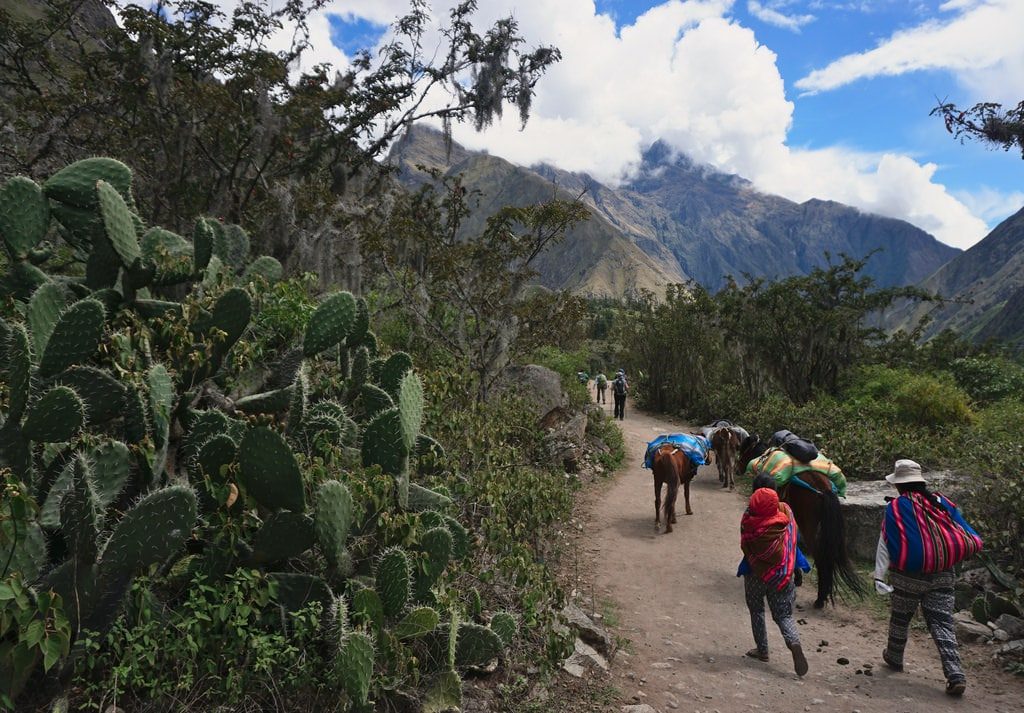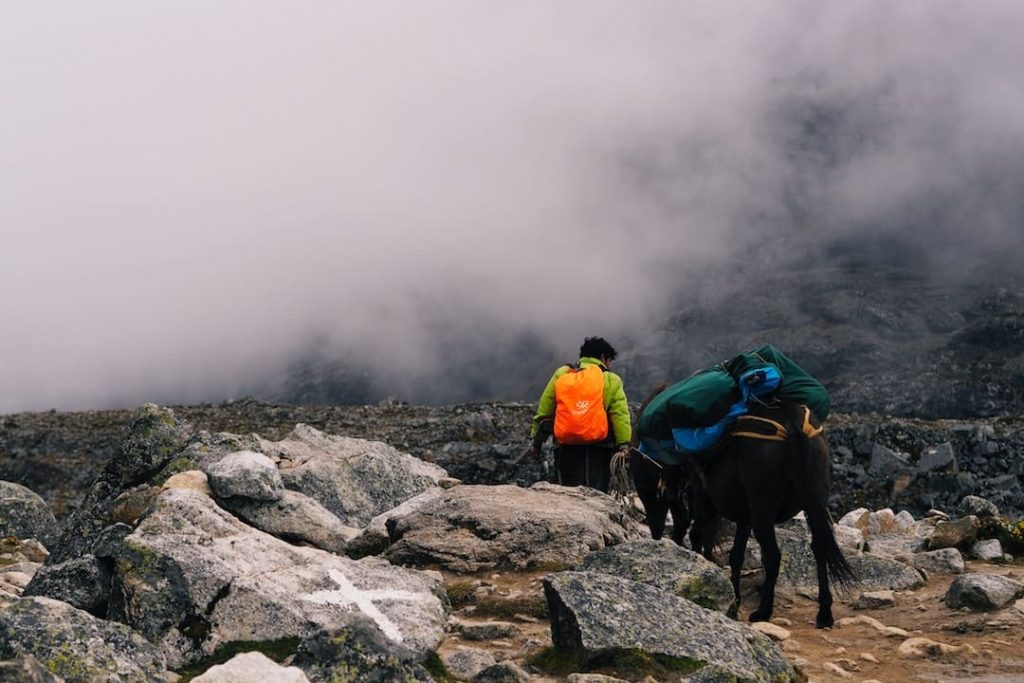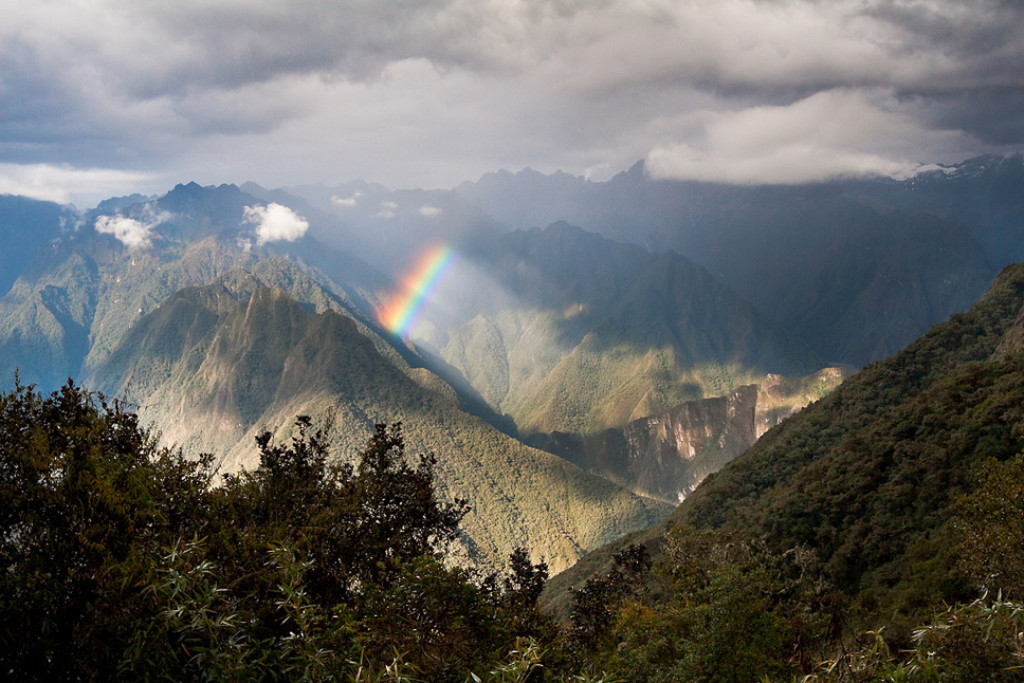If you’re thinking about making the trek to Machu Picchu on foot, there’s one major decision that’s likely standing in your way: which route are you going to take? The Inca Trail, famous for its place in history on the Royal Road system, is an ancient set of trails that connected the Inca empire to Machu Picchu. On the other hand, the Salkantay Trek is a visually stunning journey through some of the most breathtaking views in Peru, secluded from tourists and close to nature.
Both trails are beautiful, historic, and ultimately lead to one of the most amazing wonders of the ancient world. It’s merely a matter of weighing the pros and cons and deciding which trail is a better fit for you as a hiker and a traveller. Read on to find out which route is best for you!
Inca Trail | Salkantay Trek | |
|---|---|---|
| Distance | 45 kilometres | 55 kilometres |
| Average Duration | 4-5 days | 5 days |
| Average Difficulty | Moderate difficulty | Challenging |
| Highest Point | Dead Woman’s Pass: 4,215 m | Salkantay Pass: 4,600 m |
The Inca Trail
The Inca Trail is consistently rated as one of the best treks in South America — and the world. As an ancient road system built by the Incas, it holds a sacred significance to Inca culture and its traditions. It’s this combination of reputation and history that makes it the most popular route for travellers looking to visit the holy site.

Pros
The History – Hiking the Inca Trail to Machu Picchu allows modern-day travellers to experience what the Inca did as they trekked through the holy mountains to the citadel. From walking through the Sacred Valley to entering through the Sun’s Gate, one can experience nearly what an ancient civilization did, in the modern day.
The Facilities – Because the Inca Trail is the most popular route option, the trail is equipped with the most basic traveller needs. Bathrooms and showers are available throughout the walk, and for the most part, they are well maintained.
The Difficulty – When compared to some of the other routes leading to Machu Picchu, The Inca trail is the least difficult. On the second day you’ll come to the routes highest point, Dead Woman’s Pass, but aside from this small section, the trail is not hard. All ages and hiking ability levels should be able to complete this hike without much trouble.
Cons
The Crowds – Remember, it’s the most popular route. So that means you’ll need to get used to being around lots and lots of other tourists. From the campsites to the trail, you’ll be with dozens of other tourists all day, every day. While the government of Peru does have daily limitations on this route, it’s still the busiest option by far.
The Wildlife – Because this route is the busiest, the odds of seeing much abundant wildlife are slim. Foxes, deer, and chinchilla all tend to avoid these areas because they are so densely populated with tourists. It’s also a popular opinion that other routes, like Salkantay, have better scenery beyond the jungles and rolling hills.
The Price – Depending on which tour company you go with, the price for the Inca Trail is nearly always inflated. It’s the most popular, there are limits to 500 entrants a day, and the demand is high. It’s only natural that the charges would be higher. Because this route is popular, you also need to book far in advance; otherwise, you risk not getting a spot. Oh! And if you’re thinking of doing it solo, that’s not allowed. A guide must accompany all hikers on the Inca Trail.
The hiker best suited for this trail is ambitious but realistic. They may be a new hiker or an older hiker, but regardless, they want to follow in the footsteps of the ancient Incas. They enjoy meeting new people and socializing with other travellers as they take to the trails. And above all, they value a shower and a toilet that comes with a seat.
The Salkantay Trek
The Salkantay route has quickly become the second most popular option for making it to the famous citadel of Machu Picchu. While it might hold less historical significance, this option boasts dramatic landscapes, from breathtaking mountain ranges to bright blue lakes. It also gives hikers the chance to experience the natural beauty of Peru without the overflow of eager tourists.

Pros
The Solitude – Compared to the Inca Trail, the Salkantay Trek gets fewer tourists. In fact, on average 72 percent less, with around 200 hiking the Inca Trail each day and only 70 opting for Salkantay. This gives hikers the chance experience the trail in solitude, practice their nature photography, and even catch a glimpse of some outstanding Peruvian wildlife.
The Scenery – For those who decide to take the Salkantay route, you’re in store for some fantastic landscapes. This route is famous for its scenery, which most guides and trekkers will agree surpasses that of the Inca Trail. You’ll get a taste of it all, from lush valleys, snow-topped glaciers, and dense jungle: all in one hike. For some, it’s this single factor that makes the Salkantay route the more attractive option.
Availability – You guessed it. Because this isn’t the most popular option, availability, price, and flexibility are better than the Inca Trail. You can often book tours the day of and save a lot of money opting for this route over others. For anyone backpacking or looking for less commitment, this is a key selling point.
Cons
The Facilities – While this route is ideal for its solitude, but it’s that same factor that makes it less popular for facilities. You won’t find showers or bathrooms along this route, so remember to bring your toilet paper and hand sanitizer. If you’re not into the natural bathroom, you might want to think about a different route option.
The History – Some hikers find the lack of history on this route a turn-off. While this option does still offer some ancient history, it is considerably less than the Inca Trail. With this option, you sacrifice history for open trails with better views.
The Difficulty – The Salkantay Trek is hands down more difficult than the Inca Trail for a few reasons. Firstly it’s longer — almost twice as long. This route is also a lot higher, meaning the risk of altitude sickness is greater and the nights tend to be colder. For anyone worried about their physical abilities and comfort, this route might not be the best option.
The hiker best suited for this trail is a nature lover. They aren’t afraid of pushing themselves if it means the payoff is going to be huge. While they love chatting with fellow hikers, they value the option to veer off from the group and stroll independently. They don’t mind going to the washroom outdoors and have always loved washing in a lake or stream. Above it all, this person values the deep connection that travel brings them with nature and landscapes.
Inca Trail vs. Salkantay: tips to help you decide
As mentioned, making the decision isn’t easy. What’s so fabulous about one trail reminds you of what you crave in the other. The best idea would be to do them both! But until then, here are some tips that might help to make your decision a bit easier.

- Consider your interests. Is it photography? Nature? History? Whatever it is, knowing what you expect out of the hike will make the decision easier.
- Know your budget. As mentioned, different routes have different costs. So evaluate that and shop around before you decide. It shouldn’t be your only factor when choosing, but it’s still something to consider.
- Know your travel style. This is a big one! Everyone travels differently. Some people prefer to roam in solitude, while others want nothing more than to talk to others. Know where you fit and decide accordingly.
- Test your abilities. Seriously, don’t push yourself more than you can handle. It isn’t safe for you or your guides. If you know, one route might be too challenging, reduce the risk and pick a more comfortable option.
- Do the research. Each route is unique in its ways. Knowing them will help you decide. So read travel forums, travel books, travel reviews. Get to know the trails!
- Talk to the guides. Before you book, don’t hesitate to email different tour companies to figure out what they think. Often it’s these locals that are the best at helping you determine which option is the right fit.
Above all, remember that regardless of which route you choose, you’re going to see amazing things, meet amazing people, and learn amazing things. No option is better or worse – just options that are different. Get exciting knowing that whichever option you choose, you’re going to make it to the top of one of the world’s greatest wonders: Machu Picchu!


